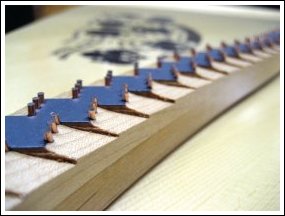Restoration
 |
Hand-carved piano bridge |
The soundboard, bridges, strings, pinblock and plate
The soundboard is the life and breath of the piano. Made of fine, tightly-grained spruce, the soundboard acts as a transducer to move the air, creating sound. The bridge, a piece of hard rock maple meticulously carved and calibrated, transmits the vibration of the strings to the soundboard with a minimal loss of energy. Piano strings come in two types: wire treble strings and copper-wound bass strings. They are terminated at a tuning pin that is driven into a cross-laminated maple pin block and hitched into a pin in the cast iron harp. The plate, or harp, supports twenty tons of string pull when the instrument is at concert pitch.
The action mechanism, keybed and pedal system
The action, an intricate mechanism made of wood, felt, leather and metal, transmits the energy of the pressed key into the string, exciting it and thus producing sound. For the pianist to enjoy the full tone and range of nuance that a fine instrument is capable of producing, the action must be in superior working order and in fine adjustment. The keybed supports the key frame which houses the keys and action mechanism. The pedal system includes a series of levers that lift the damper tray for the sustain pedal, activate the sostenuto blade for the sostenuto pedal or shift the key frame with the una chorda pedal.
Follow the link below for an in-depth look at the restoration process.

